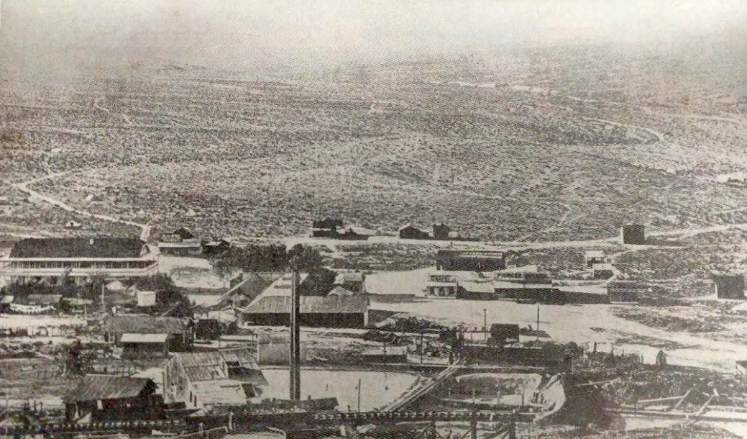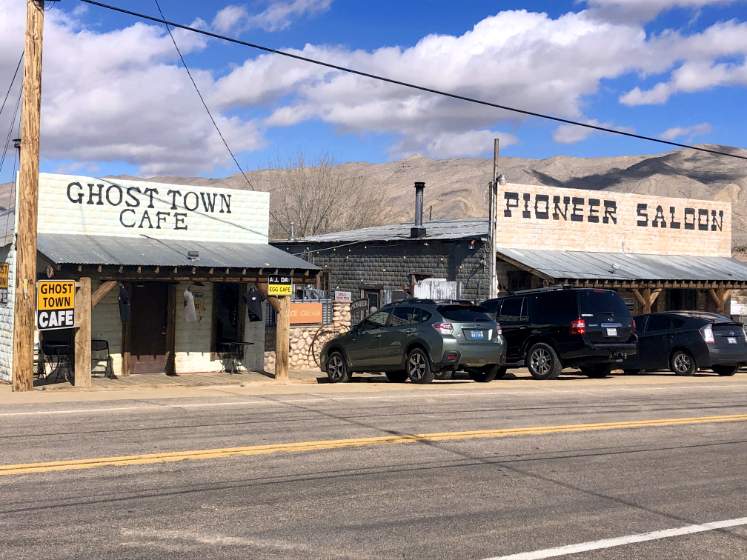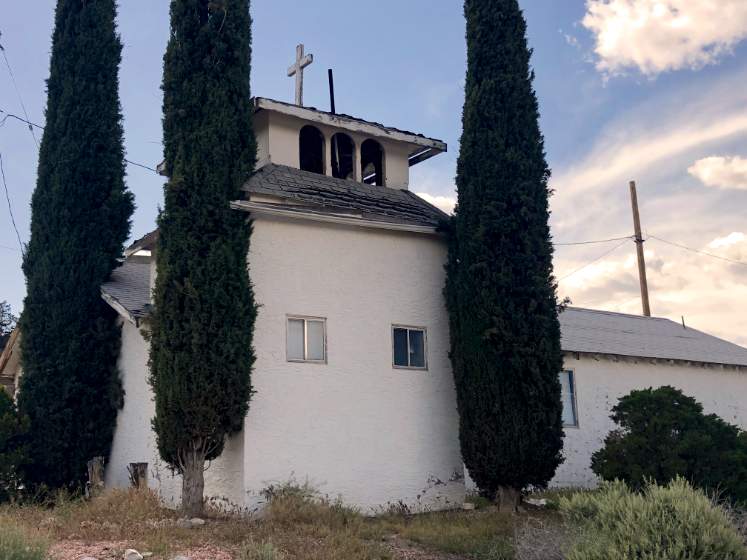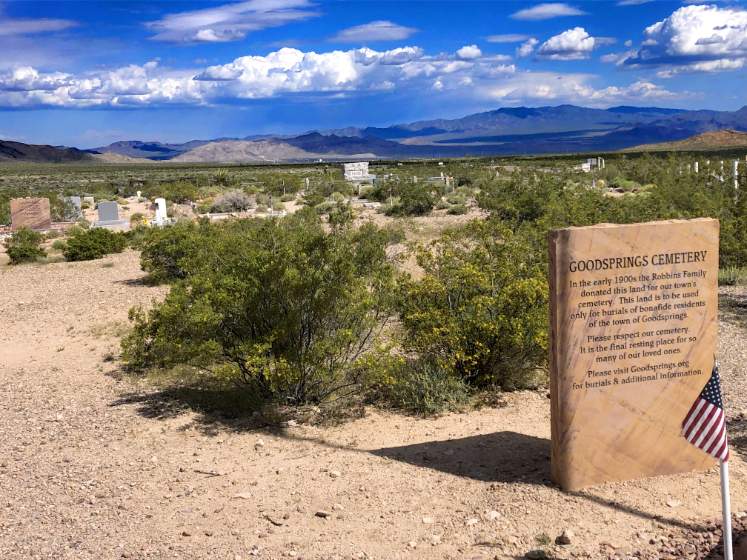
Goodsprings

"Ore deposits readily recognized in the faulted and folded limestone deposits of this district remained unworked until 1856, when Mormons began work at Potosí, establishing perhaps the oldest underground mine in Nevada. Named for cattleman Joseph Good, the open springs area was developed into the mining-ranching community of Goodsprings by A.G. Campbell. With completion of the Los Angeles-Salt Lake Railroad in 1905 and the narrow-gauge Yellow Pine Railroad from Jean to Goodsprings in 1911, transportation costs of the local oxidized zinc minerals were reduced. The peak year of operations was reached in 1916 when Goodsprings had 800 residents. This district, with the greatest variety of minerals in Nevada, produced a total of $25 million, primarily in lead and zinc, with lesser amounts of gold, silver, copper, molybdenum, vanadium, nickel, cobalt, platinum, palladium, and uranium." (Nevada Historical Marker 102)

"These two structures were erected by George Fayle using prefabricated kits. The exterior and interior walls and ceilings are of pressed tin, notable examples of early 20th century cost effective construction. The cherry wood front and back bars, manufactured by the Brunswick Company, came from a saloon in Rhyolite and have been in the building since it opened. In 1916, Goodsprings boasted 7 bars and 6 cafes, but only these two remain. Both are currently open for business." (Goodsprings Historical Society Walking Tour Brochure)

"The school’s listed on the National Register of Historic Places. It was built in 1913 for $2000. The section across the back was added in 1916. Over the years the school has been remodeled, but still stands as completed with a 1916 addition. The bell and bell tower date to 1913. The school is still in use today." (Goodsprings Historical Society Walking Tour Brochure)

"A small artesian spring surfaced near here that attracted the Anazazi and Paiute Indians who camped nearby in prehistoric times and early historic times. In 1830, the spring also served Antonio Armijo’s caravan of 60 men and 100 mules, who stopped here on their groundbreaking trip from Santa Fe to Los Angeles. This historic journey made the first overland connection between New Mexico and California, establishing a route now called the Old Spanish Trail. Later travelers found shorter routes that crossed the Spring Mountains via Mt. Springs Pass to the North. The spring was named for Joseph Good, a miner who prospected the mountains but also ran some cattle in the valley. The original spelling was “Goods Spring,” but the post office changed the name to “Goodsprings” when it established a branch here in 1899." (Goodsprings Historical Society Walking Tour Brochure)

"This building, a WWII army barracks from the Tonopah Military Base, was moved here in 1950 to serve as a community center. It has hosted social activities, church services, and the first Citizens Advisory Council Meetings. From 1988 to 1999, a corner of the building held the post office. In the late 1980s, the county built the community center next to the school. Since then, all the public functions have moved to the new facility, in the Goodsprings Community Park. The Goodsprings Historical Society opens the old club house during community celebrations for special historical displays." (Goodsprings Historical Society Walking Tour Brochure)

"Originally, the Goodsprings Mission Church served the town, until the 1930’s. During the decades when the town lacked a dedicated church building, services were held in private homes and at the Community Club House. A visiting minister from Las Vegas now holds regular services here." (Goodsprings Historical Society Walking Tour Brochure)

"Once a dwelling, this cabin was the post office from 1950-1988. “Coyote Don” moved the building to this site and restored it in 1990." (Goodsprings Historical Society Walking Tour Brochure)

"This cemetery’s oldest marker belongs to Anna Nimmer, who died in 1890. The large headstone marks the resting place of George Fayle and his family. Fayle controlled most of the business interests in Goodsprings and Jean in the early ‘teens. Jean, Nevada was named for his wife, who was post-mistress at Goodsprings while he served as postmaster of Jean. George Fayle was a Clark County Commissioner when he died in 1918 at age 37, a victim of the flu epidemic." (Goodsprings Historical Society Walking Tour Brochure)
"This small spring, first used by Anasazi and Paiute people, also sustained the caravan that pioneered a pack route now known as the Old Spanish Trail. En route to Los Angeles from Santa Fe, trader Antonio Armijo, 60 men and 100 mules camped here on January 11, 1830. The spring was named for miner Joe Good, who watered cattle here in the 1860s.
The spring was artesian, promising adequate water for a mill and town if wells were drilled. Increasing mining activity in the 1860s and 1870s led to the formation of the Yellow Pine Mining District in 1882. A. G. Campbell, Jonas Taylor and William Smith built the first permanent structure, a stone building still standing north of State Route 161. The 1893 discovery of the Keystone gold deposit brought many prospectors to the area. During the same time Sam Yount was operating a store in the stone building which stands south of State Route 161. On April 6, 1899 mail service was established and the Post Office changed the town’s name to Goodsprings.
The Yellow Pine Mining Company, established in 1901, soon became the biggest lead and zinc mine in Nevada. In 1911 the mine built a narrow-gauge railroad connecting the mine to the mill in Goodsprings, four miles away, and continuing seven miles to the main line at Jean. The demand for minerals during WWI and the new railroad connection fueled Goodsprings’ biggest growth, with the population reaching over 800. By 1917 when America entered the war, the town had a new expanded school and its own newspaper. George Fayle built a first-class hotel, general store, bar and café. Fayle served as a County Commissioner from 1912 until his death during the 1918 flu epidemic. Goodsprings’ economic decline began after WWI but mining activity never stopped and the mining claims still produce a wide variety of minerals."
(Clark County Park)